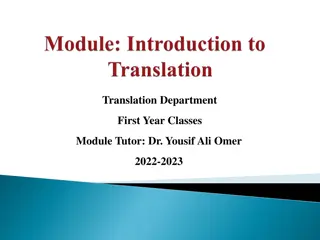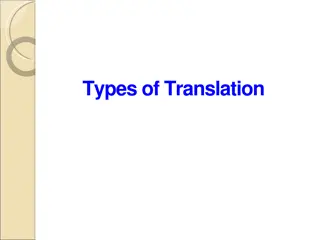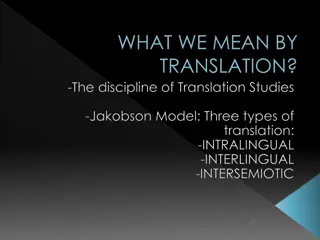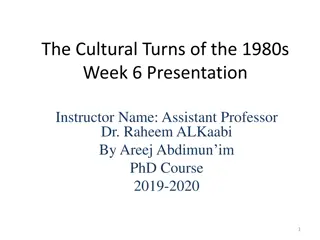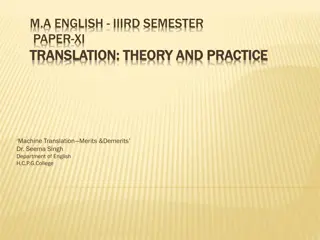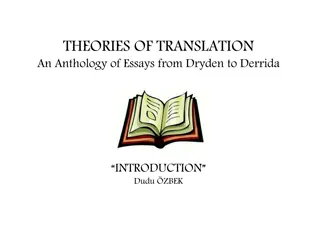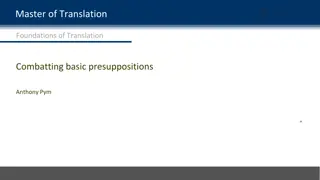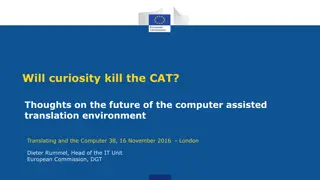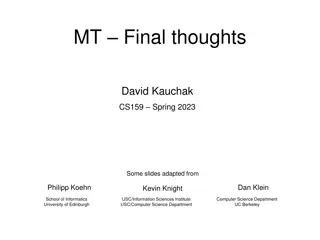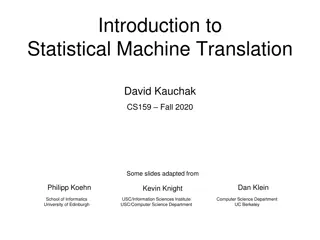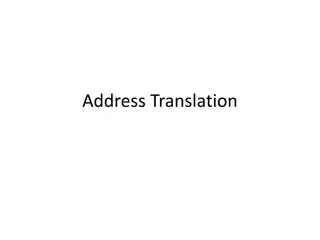Impact of Translation on Machine Learning Models: SOII Autocoder Case Study
This case study explores the effects of translating Spanish cases to English on the performance of the SOII Autocoder used in analyzing occupational injuries and illnesses data. The study aims to improve Autocoder performance by comparing the detection and translation of Spanish cases to English against using only English data. Language detection methods and evaluation strategies are discussed to address the challenge of unlabeled Spanish cases in the dataset.
Download Presentation

Please find below an Image/Link to download the presentation.
The content on the website is provided AS IS for your information and personal use only. It may not be sold, licensed, or shared on other websites without obtaining consent from the author.If you encounter any issues during the download, it is possible that the publisher has removed the file from their server.
You are allowed to download the files provided on this website for personal or commercial use, subject to the condition that they are used lawfully. All files are the property of their respective owners.
The content on the website is provided AS IS for your information and personal use only. It may not be sold, licensed, or shared on other websites without obtaining consent from the author.
E N D
Presentation Transcript
The Effects of Translation on Machine Learning Models: A Case Study from the SOII Autocoder Daniel Todd Data Scientist Bureau of Labor Statistics Office of Compensation and Working Conditions 1 U.S. BUREAU OF LABOR STATISTICS bls.gov
Survey of Occupational Injuries and Illnesses (SOII) Establishment survey >200k injuries reported/year Information such as: Job title Source of injury Part injured Etc. 2 U.S. BUREAUOF LABOR STATISTICS bls.gov
SOII Case Coding Example Example Narrative Job title: Sanitation worker Codes Assigned Occupation: 37-2011 (Janitor) Nature: 111 (Fracture) Part: 420 (Arm) Event: 422 (Fall, slipping) Source: 6620 (Floor) What was the employee doing just before the incident? Mopping floor in gym What happened? slipped on wet floor and fell What part of the body was affected? fractured right arm What object directly harmed the employee? wet floor 3 U.S. BUREAUOF LABOR STATISTICS bls.gov
Problem Question Known Spanish cases exist in our dataset Unknown how many Not labeled as Spanish Unknown effects on SOII Autocoder performance Would detecting and translating Spanish cases to English improve Autocoder performance? 4 U.S. BUREAUOF LABOR STATISTICS bls.gov
Approach Compare the Autocoders performance when trained w/ Spanish & English cases (current method) to Autocoder trained on just English cases Detection - We don t know which cases are in Spanish Translation - Once we have an idea of which cases are Spanish, we need to translate them to English Evaluation - How did we do at detecting and translating since there are no labels for us to manually compute a metric. 1. 2. 3. 5 U.S. BUREAUOF LABOR STATISTICS bls.gov
Language Detection Several options exist Most tend to use ML Needed to be run locally to protect data privacy (can't use google translate) Two Detection methods investigated: Langdetect (Non-Deterministic) https://pypi.org/project/langdetect/ xlm-Roberta-base-language-detection (Deterministic) https://huggingface.co/papluca/xlm-roberta-base-language- detection 6 U.S. BUREAUOF LABOR STATISTICS bls.gov
Langdetect Results (PR Subset) <50% of cases labelled None Excluding none predictions, <31% of cases labelled as languages other than Spanish/English High error rate with large portion of cases unclassified *All shown languages were predicted* 7 U.S. BUREAUOF LABOR STATISTICS bls.gov
XLM-Roberta Results (PR Subset) 70% of Puerto Rican Cases detected as Spanish <7% of cases labelled as languages other than Spanish/English After Spanish/English the next most frequently predicted language is Portuguese *All shown languages were predicted* 8 U.S. BUREAUOF LABOR STATISTICS bls.gov
Extrapolation on Puerto Rico 300 cases randomly selected 31% False Negative Rate (Predicted English but was Spanish) 2% False Positive Rate (Predicted Spanish but was English) 9 U.S. BUREAUOF LABOR STATISTICS bls.gov
XLM-Roberta Results (All U.S./Territories) 98% of US Cases detected as English No State/Territory besides Puerto Rico had less than 97.5% of cases in English *All shown languages were predicted* 10 U.S. BUREAUOF LABOR STATISTICS bls.gov
Translation Each Reviewer given 100 unique translated cases 62.5% of Spanish Translations Acceptable 57.5% of Portuguese Translations Acceptable Translation Model : opus-mt-es-en (https://huggingface.co/Helsink i-NLP/opus-mt-es-en) 11 U.S. BUREAUOF LABOR STATISTICS bls.gov
Model Training Two identical models were trained One trained using translated inputs Other trained using non-translated inputs Both have identical outputs 12 U.S. BUREAUOF LABOR STATISTICS bls.gov
SOII Autocoder Results Not Translated Accuracy 81.36 Translated Accuracy Not Translated F-1 54.51 Translated F-1 Gold Standard Dataset Puerto Rico Holdout Dataset 81.09 Gold Standard Dataset Puerto Rico Holdout Dataset 53.92 76.67 74.83 48.63 47.94 13 U.S. BUREAUOF LABOR STATISTICS bls.gov
Conclusions Observed decrease in both primary recorded metrics on both test cases Implies Autocoder: Can correctly code cases in Spanish Detection/Translations are insufficient at providing useful information to the Neural network Only approximately 1% of all U.S. cases are believed to be in Spanish including Puerto Rican cases 14 U.S. BUREAUOF LABOR STATISTICS bls.gov
Acknowledgements Computer Assisted Coding (CAC) Team David Oh Robert Deetz Drake Gibson Matt Gunter Matthew Haines Kolby Houghton David Losada Spanish Translation Reviewers Leah Dove Alessandra De La Pava 15 U.S. BUREAUOF LABOR STATISTICS bls.gov
QUESTIONS? 16 U.S. BUREAUOF LABOR STATISTICS bls.gov
Contact Daniel Todd Bureau of Labor Statistics Office of Compensation and Working Conditions Todd.Daniel@bls.gov 17 U.S. BUREAUOF LABOR STATISTICS bls.gov




